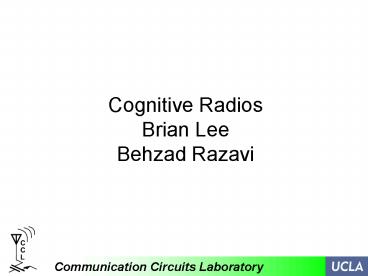Cognitive Radios Brian Lee Behzad Razavi
1 / 36
Title:
Cognitive Radios Brian Lee Behzad Razavi
Description:
... stringent 'Sensitivity' requirements with new definition of 'Band-of-Interest' ... I/Q mismatch, quantization, phase noise, etc. Goal: RF-Assisted Cognitive ... –
Number of Views:235
Avg rating:3.0/5.0
Title: Cognitive Radios Brian Lee Behzad Razavi
1
Cognitive RadiosBrian Lee Behzad Razavi
2
Research Problem
- Challenge
- Wideband sensing with stringent Sensitivity
requirements with new definition of
Band-of-Interest - Initiation
- Effects of RF non-idealities on Spectrum Sensing
- I/Q mismatch, quantization, phase noise, etc
- Goal
- RF-Assisted Cognitive Radio
- How to speed up spectrum sensing with the aid of
RF Analog design? - Design architectures/circuits that could enable
wideband Spectrum Sensing CR - Finding ways to increase the efficiency of CR
through novel RF Analog BB techniques
3
D. Cabric
4
(No Transcript)
5
(No Transcript)
6
Research Problem
- Challenge
- Wideband sensing with stringent Sensitivity
requirements with new definition of
Band-of-Interest - Initiation
- Effects of RF non-idealities on Spectrum Sensing
- I/Q mismatch, quantization, phase noise, etc
- Goal
- Enable RF-Assisted Cognitive Radio
- How to speed up spectrum sensing with the aid of
RF Analog design? - Design architectures/circuits that could enable
wideband Spectrum Sensing CR - Finding ways to increase the efficiency of CR
through novel RF Analog BB techniques
7
Cognitive Radio
- Spectrum Sensing
- Reliably sense the spectral environment
- Wideband sensing w/ Large Interferences
- ADC speed, DR, linearity
- Sensitivity
- Negative SNR (lt-23 dB) detection, ADC resolution
- Cognition
- Detect primary users
- Digital Signal Processing Gain
- Energy / Pilot / Feature / Mixed detection
- Adaptation
- Wideband PA, up-conversion, matching
8
Detection Schemes
- Energy detection
- Simplest scheme, but
- Long Sensing time requirement O(1/SNR2)
- very sensitive to noise variation uncertainty
- Pilot Detection
- Better detection rate for negative SNR signals
- Synchronization Phase noise is a critical issue
- Feature Detection
- Again better performance over negative SNR
- Sensitivity to sampling clock offset
9
Energy Detector Model
T
10
Demystifying Feature Detection
11
What is Feature Detection?
- Exploits the cyclo-stationary characteristics of
a digitally modulated signal - Extracts the embedded periodicity within signal
- Spectral Correlation Function
- Feature
- SNR 10dB
- fc 10MHz
- BW 20MHz
- fs 100MHz
- FFT 256 points
12
Spectral Correlation Function
- Exploits the cyclostationary characteristics of a
modulated signal - Sine wave carriers, pulse trains, repeating
spreading, hoping sequences, or cyclic prefixes
built in periodicity - SCF Extracts the embedded periodicity within
signal
- Stationary random signals,
- non-overlapping frequency bands are uncorrelated
- Cyclostationary signal,
- widely separated spectral components are
correlated - due to spectral redundancy caused by
periodicity
13
_ 2
a 0 PSD
_ 2
_ 2
_ 2
Cabric, Course Material
14
Cabric, Course Material
15
Spectral Correlation Function
Cyclic Autocorrelation Function
Cyclic Frequency
Spectral Correlation Function Spectrum Cyclic
Density Cyclic Spectral Density
16
Spectral Correlation Function
17
Understanding the Plots
a 0
a 1/To
QPSK Signal -Fs 100MHz -Fsym 20MHz -roll off
0.5
Gardner, 1994
18
How does Averaging help?
- Effectively lowers noise floor
- Feature power remains the same
- Needed to accurately measure feature power, with
the penalty of increased sensing time
100 spectral averages
10000 spectral averages
19
Sensing Time on SCF
100 Spectral Averages
1,000 Spectral Averages
10,000 Spectral Averages
20
How does Noise hurt?
- Noise is not periodic
- gt limited effect on feature
- Feature simply gets buried under noise
- gt Need to increase sensing time for same
performance
SNR 0 dB
SNR 10 dB
21
Gardner, 1994
Cabric, Course Material
22
Energy vs Feature
Two stage detection has been suggested
23
Accurate ADC Jitter Model
- PLL LTI noise transfer function shapes the phase
noise on sampling clock
24
Noise by Jittery Clock
25
Reference CLK Sampling CLK
26
Transfer Function Offset
27
Noise by Jittery Clock
28
(No Transcript)
29
(No Transcript)
30
(No Transcript)
31
Phase Noise Power Calculations
A
- If given,
- 1. erms jitter
- 2. sampling frequency
- 3. input signal info
- frequency
- power
- 4. Transfer function
- from noise source to PLL output phase noise
- We can predict the phase noise power at any
particular frequency of interest
B
C
D
A -105.7 dBV2/Hz B -108.5 dBV2/Hz C -128.6
dBV2/Hz D -134.4 dBV2/Hz
32
Jitter Requirements
- Acceptable Phase Noise
33
Jitter Requirements
- 10 bit ADC with Vfs 2 V
34
(No Transcript)
35
Sensing Time (SNR)
36
Strong Interferer Sampling noise
For 10-bit ADC, Pint -34.866 dBm Pint / No
129.133 dB
For 0.2 dB degradation, Sampling clock phase
noise requirement -139 dBc / Hz _at_ 5MHz































